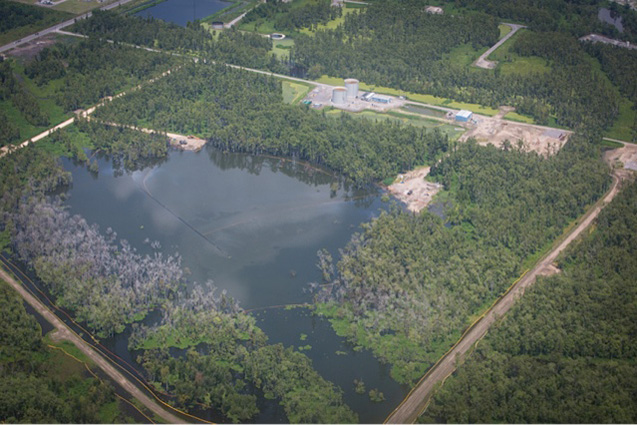
Life at Louisiana's Toxic Sinkhole: An Eco-Disaster Continues With No End in Sight
 Aerial view of sinkhole that has grown from 3 acres to 24 acres since over the course of a year. (Photos: Julie Dermansky)
Aerial view of sinkhole that has grown from 3 acres to 24 acres since over the course of a year. (Photos: Julie Dermansky)
The view from Mike Schaff's small airplane is startling. Bayous snake through pastures and swamp forest of Assumption Parish in rural Louisiana. Small residential neighborhoods and gangly networks of petrochemical pipelines, storage tanks and wastewater impounds dot the landscape. In the middle of it all is what looks like a small lake that has spilled into the swamp forest and left patches of cypress trees dead and gray. But the body of dark liquid is not a lake, and it's not supposed to be there.
We're flying over Bayou Corne on the one-year anniversary of an unprecedented environmental disaster. The trouble started last May, when small earthquakes rumbled through the area, and fisherman observed the bayous boiling like crawfish pots in certain spots. Then, on August 3, 2012, an underground salt brine cavern collapsed beneath Bayou Corne, and a massive sinkhole opened up on the surface, replacing swamp forest with an expanding slurry pit of oil and salty water from deep underground. Since Truthout first reported on the disaster in December, the sinkhole has grown from eight acres to 24 acres across.
Observers point out that there is at least some good news. While the sinkhole continues to expand, it appears to be growing away from the neighborhood of 150 homes that has been under a continuous evacuation order for the past year.
Nick Romero speaking at commemorative ceremony held on day marking one year of the sinkhole.
Back on solid ground, Schaff cracks a beer and sits down in his kitchen. His house is nestled in the neighborhood less than half a mile from the sinkhole. Like a portion of his 350 neighbors, Schaff has chosen to continue living in his house despite the evacuation order that local officials say is justified by continued threats posed by the sinkhole. Others - especially those raising children, Schaff noted - have left the neighborhood they once called home.
He points to two small air monitors that have been installed to warn him if poisonous and flammable gases creep into his house from underground. Schaff says he is ignoring the evacuation order, which has no clear end in sight, because he doesn't want to live in a motel room or impose on family and friends. He had planned on spending the rest of his life here, and he refuses to leave unless his house fills up with gas. "If I die here because of gas, then I die here," he says.
Schaff is angry, and he's angry with Texas Brine, a Houston-based firm that has operated three underground brine caverns under the sinkhole for decades. The company extracts salty brine, which is used by nearby petrochemical facilities, from a large, dome-shaped salt formation underground. Last year, the wall between one of Texas Brine's caverns and the salt formation collapsed. Geologists believe that brine and other liquids were forced vertically out of the salt cavern, fracturing rock toward the surface and causing the sinkhole.
CONTINUE
